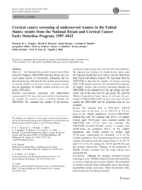
An official website of the United States government
Here’s how you know
Official websites use .gov
A .gov website belongs to an official government organization in the United States.
Secure .gov websites use HTTPS
A lock (
) or https:// means you’ve safely connected to the .gov website. Share sensitive information only on official, secure websites.
-
//
- Census.gov /
- Census Working Papers /
- Cervical Cancer Screening of Underserved Women in the United States
Cervical Cancer Screening of Underserved Women in the United States
Cervical Cancer Screening of Underserved Women in the United States
Abstract
Objective - The National Breast and Cervical Cancer Early Detection Program (NBCCEDP) provides breast and cervical cancer screens to low-income, uninsured, and underinsured women. We describe the number and proportion of women eligible for cervical cancer screening services and the proportion of eligible women screened over the period 1997–2012.
Methods - Low-income, uninsured, and underinsured women aged 18–64 years who have not had a hysterectomy are eligible for cervical cancer screening through the NBCCEDP. We estimated the number of low-income, uninsured women using data from the US Census Bureau. We adjusted our estimates for hysterectomy status using the National Health Interview Survey and the Behavioral Risk Factor Surveillance System. We used data from the NBCCEDP to describe the number of women receiving NBCCEDP-funded screening and calculated the proportion of eligible women who received screening through the NBCCEDP at the national level (by age group, race/ethnicity) and at the state level by age group. We used the Medical Expenditure Panel Survey to estimate the pro- portion of NBCCEDP-eligible women who were screened outside the NBCCEDP and the proportion that are not screened.
Results - We estimate that in 2010–2012, 705,970 women aged 18–64 years, 6.5% (705,970 of 9.8 mil- lion) of the eligible population, received NBCCEDP-funded Pap tests. We estimate that 60.2% of eligible women aged 18–64 years were screened outside the NBCCEDP and 33.3% were not screened. The NBCCEDP provided 623,603 screens to women aged 40–64 years, an estimated 16.5% of the eligible population, and 83,660 screens to women aged 18–39 years, representing an estimated 1.2% of the eligible population. The estimated proportions of eligible women screened in each state ranged from 1.5 to 32.7% and 5% to 73.2% among the 18–64 and 40–64 years age groups, respectively. Changes in the proportion of eligible women screened over the study period were nonsignificant.
Conclusions - Although the program provided cervical screening to over 700,000 women between 2010 and 2012, it served a small percent of those eligible. The proportion of women screened varied substantially across age groups, racial/ethnic groups, and states. Many low-income, uninsured women are not being screened
Share
Related Information
Some content on this site is available in several different electronic formats. Some of the files may require a plug-in or additional software to view.
 Yes
Yes
 No
NoComments or suggestions?


Top

